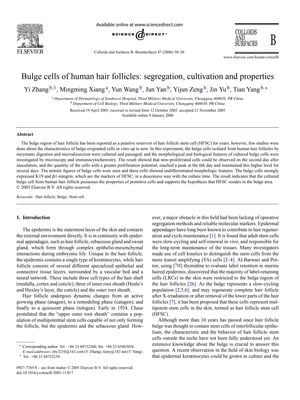TLDR Researchers found that bulge cells from human hair can grow quickly in culture and have properties of hair follicle stem cells, which could be useful for skin treatments.
In the 2006 study by Zhang et al., researchers isolated and cultured bulge cells from human anagen hair follicles to investigate their properties as hair follicle stem cells (HFSCs). The cultured cells proliferated rapidly, with proliferation observed as early as day 2, peaking at day 6, and maintaining higher levels for several days. These cells exhibited undifferentiated features and expressed HFSC markers K19 and ß1-integrin, although these markers decreased over time in culture. The study confirmed that bulge cells are distinct from outer root sheath cells, with a higher colony-forming efficiency and the ability to generate the lower follicle and hair. The findings support the "Bulge Activation Hypothesis," suggesting that bulge-derived cells in vitro represent HFSCs in vivo, and highlight the potential of these cells for use in various dermatological applications. The number of hair follicles or bulge cells used was not specified in the summary.
82 citations
,
May 2004 in “British Journal of Dermatology” Stem cells are present in plucked hair follicles and can be maintained in culture.
949 citations
,
January 2001 in “Cell” Adult mouse skin contains stem cells that can create new hair, skin, and oil glands.
1010 citations
,
August 2000 in “Cell” Hair follicle stem cells can form both hair follicles and skin.
87 citations
,
February 2000 in “Journal of Investigative Dermatology” Stem cells in developing hair follicles move to specific areas as they mature.
32 citations
,
September 1996 in “Archives of Dermatological Research” 441 citations
,
May 1996 in “Journal of Cell Science” Keratin 19 helps identify skin stem cells, with its presence varying by body location, age, and culture stage.
 23 citations
,
December 2020 in “Frontiers in Cell and Developmental Biology”
23 citations
,
December 2020 in “Frontiers in Cell and Developmental Biology” Gene network oscillations inside hair stem cells are key for hair growth regulation and could help treat hair loss.
 170 citations
,
July 2012 in “Journal of Investigative Dermatology”
170 citations
,
July 2012 in “Journal of Investigative Dermatology” Wnt ligands are crucial for hair growth and repair.
 41 citations
,
December 2018 in “Experimental Dermatology”
41 citations
,
December 2018 in “Experimental Dermatology” Understanding how melanocyte stem cells work could lead to new treatments for hair graying and skin pigmentation disorders.
86 citations
,
February 2012 in “Journal of Clinical Investigation” Stem cells in hair follicles are diverse and change throughout the hair cycle.
 18 citations
,
December 2018 in “Expert Opinion on Biological Therapy”
18 citations
,
December 2018 in “Expert Opinion on Biological Therapy” Hair follicle stem cells are promising for wound healing but require more research for safe clinical use.
 25 citations
,
April 2021 in “The EMBO Journal”
25 citations
,
April 2021 in “The EMBO Journal” Hair follicle stem cells help maintain skin health and could improve skin replacement therapies.






